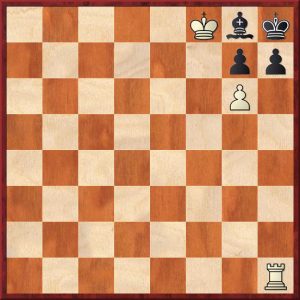In today’s article, we’ll explain how a player can improve their tactical game, turning it into a true BEAST. There is a saying that 99% of chess is tactics, showing how important having this skill well-trained is. But to be able to do that, we must understand how to train tactics and calculations correctly and most effectively.
When a beginner asks a stronger player how to improve at chess, one of the most common answers is “Do tactics/solve tactics problems”. But how to do it? With the information boom, there are many mechanisms to train, and the player can feel lost. You can use books, software, videos, and other ways to study tactics, but let’s get organized before that!
Tactical Tip: Understand the simple – understanding each tactical theme, one at a time
For the player just starting, this is the first step. But what is “simple”? The idea is to try to understand the basic tactical themes, deepen over time, and increase your ability to recognize patterns. My recommendation is to initially divide them by themes and study them one by one, doing several exercises, for example, 100 exercises per theme. Below is a list (you can find similar lists on the internet) of the main tactical themes in chess:
- Mate in 1;
- Unprotected/stuck pieces;
- Double Attack;
- Discovered Attack;
- Discovered Check;
- Double Check;
- Skewer;
- Pin;
- Mate Patterns;
- Stalemate Themes;
- Perpetual Check;
- Themes of attacking the king;
- Back-rank ;
- Deflection;
- Clearance;
- X-ray;
- Windmill;
- Interference;
- Removing the Defender;
- Sacrifices;
- Mate in 2/3;
Or you can also use the list of other platforms, for example, Lichess:

Tactical Tip: Learn how to organize your calculation
Now that you’ve studied the main tactical themes you have, it’s time to learn how to organize your calculation. Many times, when we are thinking about a position, the moves come at random, and this consumes time and energy.
My suggestion is to organize yourself with the following “checklist”: 1°See all checks; 2°See all captures; 3°See the attacks/threats.
But why exactly is this kind of move? Think with me: Checks force you to protect your king. Captures force you to react, as it ends up throwing the material balance out of balance. Attacks force you to defend or counterattack. Therefore, it makes sense that you look at Forced/Active Variants first, as they give a forced character to the game.
Let’s see how this applies in practice:

A random position from a game of lichess’s players. Let’s see what we have here: White is two pieces down, so if we don’t act quickly, Black will simply consolidate the position. Let’s see the checks we have here: 1.Qh8+, 1.Qh7+, 1.Qxg6+, and 1.Rxg6+. Of course, the first three just give away the Queen, so let’s dig deeper into the 1.Rxg6+. What can Black do? (It’s important to always think about what the opponent wants to do, as we don’t play chess alone) There are only two moves: 1…Bg7 and 1…fxg6. The first is easily refuted (1…Bg7 2.Rxg7#), so we move on to 1….fxg6.

We have two checks: 2.Qxg6+ and 2.Rxg6+.If 2.Rxg6+, Black will play 2…Kf7 3.Rxf6+ Ke7 4.Qg7+ Kf7 and White has no way to continue the attack and is short on material. So 2.Qxg6+ is our only option and happily wins for White: If 2…Bg7 3.Qxg7# and 2…Kh8 3.Qh6#. This kind of process is very slow at first, but as you practice, this “mindset” gets faster, and at some point, you may start to think about it unconsciously.
Let’s go to another example:

A practical example of mine: I played 12.Bg5 and Black played 12…Bxg5? and we have the position of the diagram. The most natural move in the world is simply to recapture the piece (which is a good move and that’s what I played, unfortunately, I had a direct win and lost the game afterward), but if we consider the checks, we managed to find the move 13.Bxh7+! (a typical king attack theme, the Greco gift, which if you followed the walkthrough of the article, you should have already seen an example) 13…Kxh7 14.Nxg5+ Kg6 14…Kg8 15.Qh5 with a crushing attack; 14…Kh6 15.Qg4, with a smashing attack with Qh4+ 15.Qg4 And Black have no way to defend against the attack.
Being able to do this organization process will help you not to think at random, and save time and energy during your games.
Tactical Tip: Train actively and daily
As obvious as this is, it makes sense to reinforce this point: Try to practice tactics every day! It’s like going to the gym: If you want your muscles to grow, you have to go every day! And when you do an exercise, try to focus: It’s better to do one exercise well, stimulating your thought processes than 100 poorly done exercises, kicking shots at random.
Another thing that will come in handy is analyzing games, seeing which tactical resources you/your opponent have omitted, and doing this in other players’ games. This will expand your repertoire of tactics, and your ability to recognize patterns.
Bonus Tip: Solve compositions
Compositions are mounted positions that are not possible to happen in a real game but are created by the beauty of the solution. It usually has a single solution, and it’s based on some beautiful, imaginative, or unexpected theme. I’ll put an example here:

Here white plays and mates in 2 moves with 1.Rh6!! A very aesthetic move! 1…gxh6 1…Ba2 2.Rxh7# 2.g7#
Conclusion
I believe that by following these steps, any player can become a tactical beast. In this process, your intuition will get better and better: But do you know what intuition is and how to train it? See in our next article!
Follow us on Facebook!
Join our club on chess.com!